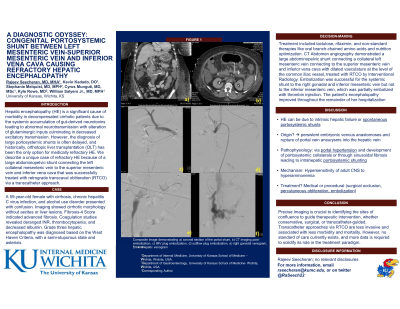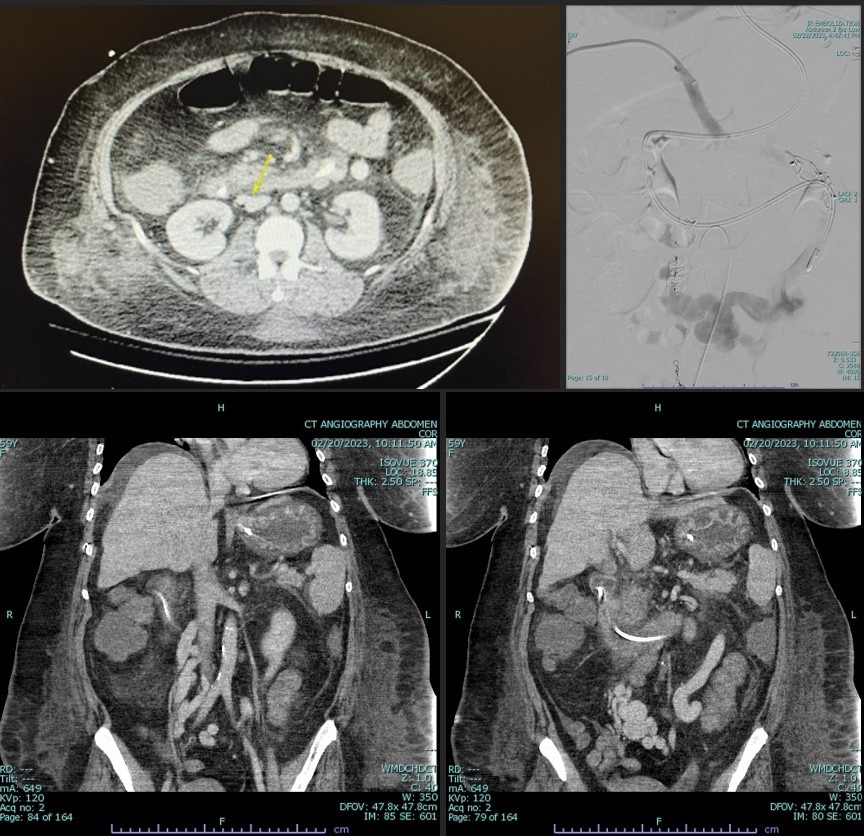Sunday Poster Session
Category: Liver
P1013 - A Diagnostic Odyssey: Congenital Portosystemic Shunt Between Left Mesenteric Vein-Superior Mesenteric Vein and Inferior Vena Cava Causing Refractory Hepatic Encephalopathy
Sunday, October 22, 2023
3:30 PM - 7:00 PM PT
Location: Exhibit Hall

Has Audio

Rajeev V. Seecheran, MD
University of Kansas School of Medicine
Wichita, KS
Presenting Author(s)
Award: Presidential Poster Award
Rajeev Seecheran, MD1, Kevin Kadado, DO1, Stephanie J. Melquist, MD, MPH1, Taylor Jones, DO1, Andrew osbeck, PA-C1, Cyrus Munguti, MD1, Kermit Rust III, MD2, Kyle Rowe, MD1, William J.. Salyers, MD, MPH1
1University of Kansas School of Medicine, Wichita, KS; 2Wichita Radiology Group, Wichita, KS
Introduction: Hepatic encephalopathy (HE) is a significant cause of morbidity in decompensated cirrhotic patients due to the systemic accumulation of gut-derived neurotoxins leading to abnormal neurotransmission with alteration of glutaminergic inputs culminating in decreased excitatory transmission. However, the diagnosis of large portosystemic shunts is often delayed, and historically, orthotopic liver transplantation (OLT) has been the only option for medically refractory HE. We describe a unique case of refractory HE because of a large abdominopelvic shunt connecting the left collateral mesenteric vein to the superior mesenteric vein and inferior vena cava that was successfully treated with retrograde transcaval obliteration (RTCO) via a transcatheter approach.
Case Description/Methods: A 59-year-old female with cirrhosis, chronic hepatitis C virus infection, and alcohol use disorder presented with confusion. Imaging showed cirrhotic morphology without ascites or liver lesions. Fibrosis-4 Score indicated advanced fibrosis. Coagulation studies revealed deranged INR, thrombocytopenia, and decreased albumin. Grade three hepatic encephalopathy was diagnosed based on the West Haven Criteria, with a semi-stuporous state and asterixis. A liver transplant was not an option due to alcohol abuse. Treatment included lactulose, rifaximin, and non-standard therapies like oral branch-chained amino acids and nutrition optimization. Alternative causes of altered mental status changes were ruled out. CT Abdomen angiography demonstrated a large abdominopelvic shunt connecting a collateral left mesenteric vein connecting to the superior mesenteric vein and inferior vena cava with dilated vasculature at the level of the common iliac vessel, treated with RTCO by Interventional Radiology. Embolization was successful for the systemic shunt to the right gonadal and inferior mesenteric vein but not to the inferior mesenteric vein, which was partially embolized with thrombin injection. The patient's encephalopathy improved throughout the remainder of her hospitalization.
Discussion: Precise Imaging is crucial to identifying the sites of confluence to guide therapeutic intervention, whether conservative, surgical, or transcatheter-guided. Transcatheter approaches via RTCO are less invasive and associated with less morbidity and mortality. However, no standard of care currently exists, and more data is required to solidify its role in the treatment paradigm.

Disclosures:
Rajeev Seecheran, MD1, Kevin Kadado, DO1, Stephanie J. Melquist, MD, MPH1, Taylor Jones, DO1, Andrew osbeck, PA-C1, Cyrus Munguti, MD1, Kermit Rust III, MD2, Kyle Rowe, MD1, William J.. Salyers, MD, MPH1. P1013 - A Diagnostic Odyssey: Congenital Portosystemic Shunt Between Left Mesenteric Vein-Superior Mesenteric Vein and Inferior Vena Cava Causing Refractory Hepatic Encephalopathy, ACG 2023 Annual Scientific Meeting Abstracts. Vancouver, BC, Canada: American College of Gastroenterology.
Rajeev Seecheran, MD1, Kevin Kadado, DO1, Stephanie J. Melquist, MD, MPH1, Taylor Jones, DO1, Andrew osbeck, PA-C1, Cyrus Munguti, MD1, Kermit Rust III, MD2, Kyle Rowe, MD1, William J.. Salyers, MD, MPH1
1University of Kansas School of Medicine, Wichita, KS; 2Wichita Radiology Group, Wichita, KS
Introduction: Hepatic encephalopathy (HE) is a significant cause of morbidity in decompensated cirrhotic patients due to the systemic accumulation of gut-derived neurotoxins leading to abnormal neurotransmission with alteration of glutaminergic inputs culminating in decreased excitatory transmission. However, the diagnosis of large portosystemic shunts is often delayed, and historically, orthotopic liver transplantation (OLT) has been the only option for medically refractory HE. We describe a unique case of refractory HE because of a large abdominopelvic shunt connecting the left collateral mesenteric vein to the superior mesenteric vein and inferior vena cava that was successfully treated with retrograde transcaval obliteration (RTCO) via a transcatheter approach.
Case Description/Methods: A 59-year-old female with cirrhosis, chronic hepatitis C virus infection, and alcohol use disorder presented with confusion. Imaging showed cirrhotic morphology without ascites or liver lesions. Fibrosis-4 Score indicated advanced fibrosis. Coagulation studies revealed deranged INR, thrombocytopenia, and decreased albumin. Grade three hepatic encephalopathy was diagnosed based on the West Haven Criteria, with a semi-stuporous state and asterixis. A liver transplant was not an option due to alcohol abuse. Treatment included lactulose, rifaximin, and non-standard therapies like oral branch-chained amino acids and nutrition optimization. Alternative causes of altered mental status changes were ruled out. CT Abdomen angiography demonstrated a large abdominopelvic shunt connecting a collateral left mesenteric vein connecting to the superior mesenteric vein and inferior vena cava with dilated vasculature at the level of the common iliac vessel, treated with RTCO by Interventional Radiology. Embolization was successful for the systemic shunt to the right gonadal and inferior mesenteric vein but not to the inferior mesenteric vein, which was partially embolized with thrombin injection. The patient's encephalopathy improved throughout the remainder of her hospitalization.
Discussion: Precise Imaging is crucial to identifying the sites of confluence to guide therapeutic intervention, whether conservative, surgical, or transcatheter-guided. Transcatheter approaches via RTCO are less invasive and associated with less morbidity and mortality. However, no standard of care currently exists, and more data is required to solidify its role in the treatment paradigm.

Figure: Figure 1 demonstrate a composite of multimodality imaging of the abdominopelvic shunt connecting the left collateral mesenteric vein to the superior mesenteric vein and inferior vena.
Disclosures:
Rajeev Seecheran indicated no relevant financial relationships.
Kevin Kadado indicated no relevant financial relationships.
Stephanie Melquist indicated no relevant financial relationships.
Taylor Jones indicated no relevant financial relationships.
Andrew osbeck indicated no relevant financial relationships.
Cyrus Munguti indicated no relevant financial relationships.
Kermit Rust III indicated no relevant financial relationships.
Kyle Rowe indicated no relevant financial relationships.
William Salyers indicated no relevant financial relationships.
Rajeev Seecheran, MD1, Kevin Kadado, DO1, Stephanie J. Melquist, MD, MPH1, Taylor Jones, DO1, Andrew osbeck, PA-C1, Cyrus Munguti, MD1, Kermit Rust III, MD2, Kyle Rowe, MD1, William J.. Salyers, MD, MPH1. P1013 - A Diagnostic Odyssey: Congenital Portosystemic Shunt Between Left Mesenteric Vein-Superior Mesenteric Vein and Inferior Vena Cava Causing Refractory Hepatic Encephalopathy, ACG 2023 Annual Scientific Meeting Abstracts. Vancouver, BC, Canada: American College of Gastroenterology.

